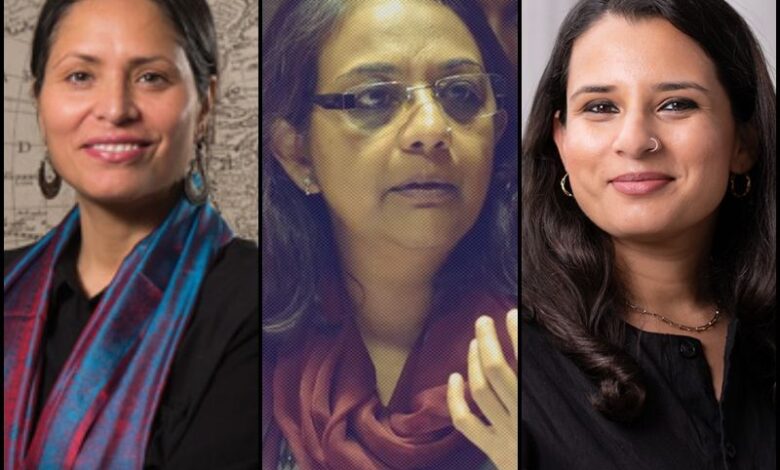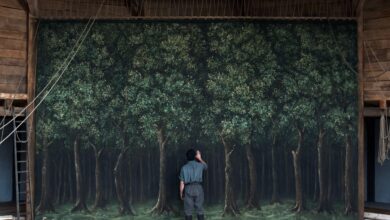‘The Attempt Is to Erase Everything’: Three Women J&K Authors on the Ban on Their Books

Ather Zia, Anuradha Bhasin and Hafsa Kanjwal talk about the situation in J&K, a history of suppression, and how they view the most recent ban on 25 books.
It is ironic that the ban on 25 books in the union territory of Jammu and Kashmir comes in the midst of a state-sponsored book festival, the Chinar Book Festival 2025, where the state is promoting its narrative of all is well and normal even as it clamps down on freedom of ideas and expression. The authors are scholars and academics – from J&K, from other parts of the country and from outside India too. The government has declared the books banned as “This literature would deeply impact the psyche of the youth by promoting a culture of grievance, victimhood and terrorism heroism.” It also blamed the books for “misguiding the youth” in Kashmir and instigated their “participation in violence and terrorism”.
The Wire spoke to three women authors whose books were banned to find out what it means for them to be silenced, and how the erasure of the Kashmiri narrative would impact the people of J&K. Excerpts from the interviews follow.
Ather Zia’s Resisting Disappearance: Military Occupation and Women’s Activism in Kashmir
My book questions, how can you disappear people? It was the technology of punishment in the ‘90s and still is in some ways, even if it’s trickled down to a very small scale today. The Association of Parents of Disappeared Persons (APDP) is at the heart of my book; women’s struggle to find their kin who were mostly noncombatants.
I ask how democracy is weaponised and how the movement for self-determination was diluted slowly and steadily to a point where if a small emoji is put on social media post, it gets criminalised.
The book looks at the ‘90s and its history, how Kashmiris have become killable bodies, that you can kill Kashmiris and there can be no remorse. It’s happening now in different ways in in parts of India. When you look at these histories, it is very different from how nation states look at them, and that’s what my book is, it’s an ethnography, a history of people from people’s vantage. Disappearances are at the heart of my book, it’s devastating for a society to have people disappear, where have these people gone? We have unidentified mass graves and we have more than 8,000 to 10,000 disappearances.
The book is in no way trying to investigate anything except to understand Kashmir from lived experiences, testimonies and testimonies of people. It is a rigorous peer-reviewed work, it’s been published by the Washington University Press in the US, and Zubaan picked up the South Asia rights. It’s a rigorous anthropological work but I don’t think it’s been in circulation since 2019.
I am also co-author of another book that has been banned, Resisting Occupation; it’s easy to see why these books have been picked because the crux of these books is history, memory, lived realities and truth-telling from a critical Kashmiri perspective. It’s also connected to human rights violations, their documentation, and archiving human rights activism. There were few documentations in English but basically we grew up with Indian narratives of a cosmetic peace in the last 70 years; so my generation growing up in the ‘80s and coming of age in the late ‘80s, early ‘90s was when we really began to comprehend what was happening around us.
The APDP has been completely silenced and they haven’t been able to speak in the last one decade.
The ban
The ban is playing the same game that has been operational even before the BJP, which is the increased silencing and criminalisation of regular Kashmiri life, their lived experiences, history, memory which these books give access to. Kashmiris have written a lot in the last 77 years in local languages but there are few books that are accessible in academia internationally. That access is now being taken away with the new list of banned books.
Banning a book today doesn’t make any sense because the written word is available digitally. But what really worries me is that that while we know books will live beyond bans, it is the level of fear around the production of knowledge and readership. The ban invokes powers where police officers can seize the books anywhere, the police can be authorised by a magistrate to go search homes and premises where copies are found or something is suspected, and reading becomes a criminal act.
After the raids on bookshops in the last two days, publishers and small booksellers are now in the crosshairs of the law.
More than the book ban itself, it’s the relationship with lived history, testimony and knowledge production that is being attacked. It’s basically the fear of ideas that is being revealed to us rather the than banning of one or two books. They’re criminalising knowledge production and critical ways of looking at a problem. The essence of any democracy, after all, is dissent.
One good thing is now a lot of people have a list to look up to when they want to really read about Kashmir, [to try and understand] why is it that a book can become become a singular threat.
I’m a poet too and I also had a book of poetry that had to be withdrawn from the local Indian ecosystem because it was problematic. I didn’t want more censorship to hit the book. There is a huge programme to institutionalise censorship in Kashmir because the book ban exists only inside Kashmir.
Kashmir Lit, the publishing house I founded in 2008, is looking for Kashmiri voices but these days there is so much silencing – [there is a] disappearance of Kashmiri writing, and archives of journalistic reports have all but vanished.
Today, all you can access from the internet inside Kashmir [are things show] the Government of India in a positive light. If you start from the arc of when this process started, the silencing inside Kashmir, the silencing of human rights organisations… My book reflects this, from Khurram Parvez, the globally feted human rights activist, who is in jail right now, to Parveena Ahanger, co -founder of APDP, they are all silenced. Now you have the book banning; it’s this arc of repression and the silencing that is operational. The book ban makes sure that all avenues of people’s expression is stifled.
This has been a consistent Delhi policy, but the difference today is that it is done in a more spectacular fashion. In 2019, one of the Congress ministers in the state had said we don’t know what they [the Modi government] is doing different with Article 370; we had tweaked it 12 times, and so discreetly that no one knew of the changes.
So the book ban is yet another message of repression to Kashmiris. Only recently, the works of two writers, the poet Agha Shahid Ali and Bashrat Peer, were dropped by two Kashmiri universities.
There may be a lot of publications in Kashmir today, but what is the quality of works that are allowed in the Valley? Right now the Chinar Book Festival is going on, and there is a giant effigy of the Brahmos missile that is in pride of place in the festival.
Anuradha Bhasin’s A Dismantled State: The Untold Story of Kashmir After Article 370
It’s about Jammu Kashmir after 2019, a counter narrative of what happened in the state after the abrogation of Article 370. The book countered the government narrative of a return to normalcy, by showing the crackdown on the media, the longest ever internet shutdown that stopped access to all information, details of detention; a lot that was happening in the state that was really not known. We tried to bring in details and data of whatever was available, through interviews, observations on the ground, analysis of the new laws and policies, and how they were impacting people.
Our findings challenged the government propaganda of a return to normalcy by showing how abnormal it was on the ground – there was a brutal crackdown on media and dissent, random arrests [on a] sweeping scale all over the state, the inability of newspapers to publish anything from the ground, and those who did publish were not saying anything at all, they were truncated versions of themselves.
The government declared not a drop of blood had been shed after Article 370, but there had been few instances of violence, of people being picked up and then being released; there was a continuous process of detention and release, some even for a long period in jails outside the state. Families didn’t know about their whereabouts, we spoke to families and some detainees and managed to get their stories.
The crackdown on freedoms not just affected journalism, but political activism in the state too – the abnormality of the situation and their inability to say or do anything is in the book. We also looked at the impact of the land laws and the development model, and how it was adversely impacting the locals.
The ban
My first reaction to the ban of books was that it was laughable in the information age, but it is yet another bullying tactic to maintain control over a people who have been forbidden to think or act against a brutal state. The ban certainly appears in line with the government’s policy of control for J&K, which they impose every now and then; so this is a new way of inducing fear among the people by banning books. It’s also in tune with the right-wing politics of eliminating alternative histories and narratives.
This book is out there for even government functionaries to read and know where they’re going wrong. But obviously they don’t want to do that. The only way they know of controlling Kashmir is through an iron fist. It is bizarre that the government needs to impose a ban when its mega propaganda has been of a return to normalcy in the state. Obviously it exposes its own propaganda as false.
However, with no access to the written word in the state, this could produce a generation of people with a patchy knowledge of Kashmir’s history, as they would have access largely to government narratives.
They’ve silenced journalism, they have disappeared the archives of newspapers; they don’t want anything in the public domain that challenges their narrative. No history. No memory. The attempt is to erase everything.
But there are murmurs again, with politicians now asking for statehood.
Hafsa Kanjwal’s Colonising Kashmir
My book looks at how in the 1950s and 1960s, the Indian government consolidated its colonial occupation of Kashmir through educational, economic and cultural policies. Bakshi Ghulam Mohammad, the second Prime Minister of the Jammu and Kashmir state, got a lot of funds from the Indian government saying Kashmiris will only be loyal as long as you provide them with certain benefits. And so the Kashmir government got a lot of funds to build schools, infrastructure, hire teachers. And what was being taught in terms of Kashmir’s history? It was heavily slanted in favour of the Indian state.
So, too, in the cultural part, where I look at long histories of state-sponsored cultural productions. There was a festival in the 1950s called Jashn e Kashmir, and it was a way for the Union government to provide patronage to Kashmiri cultural artists who were often struggling financially; and the government used these festivals to show that Kashmir was normal.
The interesting part is even today, the state has sponsored cultural festivals and concerts though the government and army in an attempt to portray that Kashmir is normal and peaceful, that there are no political aspirations that are unaligned with India, and so forth.
Journalists and tourists are brought in from outside, including international media, to show how Kashmir was progressing under India’s rule. These cultural fests where Kashmiris would be participating was to give this veneer of normalcy, and would happen every year. The specific one that I looked at in my book ended around the early 1960s after Bakshi’s role ended.
The ban
It is important to note that there was a ban on books earlier this year as well. There were a number of books published by the Jamaat e Islam and other religious organisations in Kashmir that were banned and subsequently shops were raided. It didn’t get as much international outcry as this one, as I think there is kind of a hierarchy of who gets an outcry? With the present ban, there are obviously a number of Indian as well as Western authors on the list, and of course, Kashmiri authors as well. But this censorship has been ongoing for a long time.
With the present ban I think the government’s decision has clearly backfired, because people are seeing it as a joke. If the government expected to instil fear, instead they have become a laughing stock if you see the reaction online. The state uses terror tactics to create a sense of fear or anxiety among the people, what with videos of the police going into shops in different parts of Kashmir looking through their registry of books and so on; that is the performance of power. I feel bad thinking about the shopkeepers and [those who are] being harassed with the threat of criminality over their heads. And yet at the same time, if you look online, young Kashmiris are making jokes saying the government has given us a reading list of books that we absolutely need to read; and this is a generation that’s not known for their reading.
Is this to create an atmosphere of fear and intimidation? Yes, there is that too, but even my own work looks at the beginning, from 1947, how the state, because it doesn’t have the legitimacy from the people, it finds different ways to try control information going in and out. And so this is linked to a whole host of other policies in terms of clamping down on journalism, universities, arresting and targeting human rights defenders and civil society organisations. It’s all about restricting information that is being documented, recorded and circulated within Kashmir, and also outside of Kashmir. So the idea is to suppress all the information collected by Kashmiris and erase them, and make space for narratives approved by the government that it wants to propagate.
It’s interesting that in 2025, the government thinks it can get away with a book ban. It’s unclear whether this is symbolic, or does it actually believe it will be effective? Now these books have gained a lot of visibility, academic works that would never have got visibility in the mainstream. I would say the ban has backfired.
Vrinda Gopinath is an independent journalist.
This article went live on August eleventh, two thousand twenty five, at fifteen minutes past one in the afternoon.
The Wire is now on WhatsApp. Follow our channel for sharp analysis and opinions on the latest developments.
Source link




